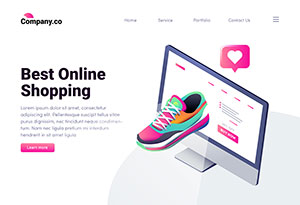
Starting an ecommerce business on Amazon is an incredible opportunity to reach millions of potential customers worldwide. Whether you’re a budding entrepreneur or an established seller looking to expand, Amazon offers the tools, support, and audience you need to succeed. However, setting up your business on the platform requires careful planning, research, and execution. This guide will walk you through everything you need to know about how to start an ecommerce business on Amazon, from creating a seller account to scaling your operations for long-term success.
Why Choose Amazon for Your Ecommerce Business?
Amazon dominates the global ecommerce market, offering unmatched visibility for your products. With over 2.5 billion visits per month, the platform attracts buyers who are already prepared to make purchases. Here are a few reasons why starting an ecommerce business on Amazon makes sense:
- Built-in customer base: Amazon attracts millions of active buyers daily.
- Trusted platform: Customers trust Amazon for reliability, convenience, and speedy delivery.
- Scalability: Whether you’re selling a few items or thousands, Amazon’s infrastructure supports your growth.
- Fulfillment by Amazon (FBA): Allows sellers to outsource storage, shipping, and customer service.
Now, let’s explore how to get started.
Steps to Start an Ecommerce Business on Amazon
1. Register an Amazon Seller Account
To begin, you need to create an Amazon Seller Account. Here’s how to do it:
- Visit Amazon Seller Central on the official Amazon website.
- Click on “Sign Up” and choose a selling plan. Amazon offers two plans:
- Individual Plan for occasional sellers.
- Professional Plan for dedicated businesses.
- Provide necessary details, including your business name, address, ID verification, and bank account information.
- Accept Amazon’s seller terms and conditions.
Pro Tip: If you’re unsure about which plan to select, start with the Individual Plan and upgrade later.
2. Create Your Amazon Seller Profile
Your seller profile helps establish credibility with customers. Make sure to:
- Add a professional logo or header photo.
- Write a compelling “About Us” section showcasing your brand’s story.
- Highlight your unique selling proposition to stand out from competitors.
3. Develop an Amazon Business Plan
Just like any business, your success on Amazon starts with a solid plan. A well-thought-out business plan should cover:
- Target audience: Who are your ideal customers?
- Product niche: What will you sell, and why will people want it?
- Budget: How much will it cost to start and maintain your Amazon business?
- Marketing strategy: How will you promote your products?
4. Understand Amazon’s Fees and Costs
It’s essential to understand the costs associated with selling on Amazon. Some key expenses include:
- Referral fees (8%–15%, depending on the product category).
- Fulfillment fees (if using FBA).
- Monthly seller subscription fee ($0 for Individual Plan, $39.99 for Professional Plan).
- Other charges such as storage and shipping costs, depending on your fulfillment strategy.
5. Choose the Right Products to Sell
Your product selection is one of the most critical factors in your Amazon business’s success. Focus on items with:
- High demand and low competition.
- Affordable sourcing and shipping costs.
- Potential for good profit margins.
Use tools like Jungle Scout, Helium 10, or Amazon Best Sellers to research profitable products and niches.
6. Source Your Products
Once you’ve decided on your products, secure suppliers. You can source products from:
- Local wholesalers or manufacturers.
- Global suppliers on platforms like Alibaba.
- Private-label goods to create your unique brand.
Ensure your products meet legal and quality standards.
7. Optimize Your Amazon Product Listings
Creating excellent product listings is key to attracting buyers. Include:
- High-quality images (consider using professional photo editing to enhance quality and consistency).
- Engaging product titles optimized with keywords.
- Bullet points listing product features and benefits.
- Keyword-rich product descriptions.
- A competitive price.
Pro Tip: Use Amazon’s A+ Content Manager to enhance your product pages with rich visuals and detailed information.
8. Set Up Fulfillment Services
Amazon gives you two primary fulfillment options:
- Fulfillment by Amazon (FBA):
- Amazon handles inventory storage, packing, shipping, and returns.
- Great for scaling and achieving Prime eligibility.
- Fulfillment by Merchant (FBM):
- You manage shipping and customer service independently.
FBA is a popular choice for beginners because it simplifies logistics.
9. Market Your Amazon Store
Once your store is live, drive traffic to your listings using these strategies:
- Amazon Advertising:
- Sponsored Products, Sponsored Brands, and Sponsored Display ads can boost visibility.
- Social Media Marketing:
- Promote products on Instagram, Facebook, Pinterest, or TikTok to attract shoppers.
- Influencer Marketing:
- Partner with influencers to recommend your products to a targeted audience.
Positive product reviews also play a significant role in building trust.
10. Analyze and Optimize Your Performance
Use Amazon Seller Analytics to monitor your store’s performance. Pay attention to:
- Conversion rates.
- Return on ad spend (ROAS).
- Inventory turnover rates.
- Customer reviews and feedback.
Make continuous improvements to maximize efficiency and profitability.
Common Challenges for Amazon Sellers
While starting an ecommerce business on Amazon is lucrative, it’s not without hurdles. Below are common challenges and how to overcome them:
- High competition:
- Differentiate your brand with unique, high-quality products and stellar customer service.
- Seller fees and margins:
- Set a competitive yet profitable pricing strategy.
- Account suspensions:
- Always comply with Amazon’s seller policies to avoid suspensions.
- Inventory management:
- Use tools like Zoho Inventory or RestockPro to track stock levels effectively.
Advantages of Starting an Amazon Ecommerce Business
Here’s why selling on Amazon is worth the effort:
- Global reach.
- Access to Prime members, who are avid shoppers.
- Amazon’s trusted reputation.
- Low barriers to entry compared to building a website from scratch.
FAQs About How to Start an Ecommerce Business on Amazon
1. How much does it cost to start an ecommerce business on Amazon?
Startup costs vary but typically include a seller account fee, product inventory, and optional expenses like professional photos or marketing. On average, budget between $500 and $2000.
2. What is Fulfillment by Amazon (FBA)?
FBA allows you to store products in Amazon’s warehouses. Amazon handles shipping, returns, and customer service on your behalf, making it ideal for sellers looking to scale.
3. How do I find profitable products to sell on Amazon?
Use tools like Jungle Scout or Helium 10 to analyze product demand, competition, and profit margins. Look for items with strong customer interest and sustainable sourcing costs.
4. What are Amazon’s seller fees?
Amazon charges referral fees (8-15% of the sale price), monthly subscription fees ($39.99 for Professional accounts), and optional FBA fees based on size and weight.
5. How can I avoid account suspension?
Follow Amazon’s guidelines, provide accurate product descriptions, and resolve customer complaints promptly. Regularly check your account health in Seller Central.
Starting an ecommerce business on Amazon can be life-changing if done right. With careful planning and execution, you can build a profitable business and establish your brand on the world’s largest online marketplace. Remember, investing in high-quality product photography and optimizing your listings can give you a competitive edge. Reach out to professionals, like Photo Fix Team, to ensure your products stand out visually. Good luck!
How We Helped an E-commerce Brand Increase Sales by 35% with Professional Retouching
When it comes to e-commerce, first impressions are crucial. A shopper’s decision to click “Add…
How to Use Ghost Mannequin Photography to Showcase Your Apparel Products
Empowering Success TogetherHow to Use Ghost Mannequin Photography to Showcase Your Apparel ProductsWe provide comprehensive…
Spring Fashion 2025: The Hottest Colors to Wear
Empowering Success TogetherSpring Fashion 2025: The Hottest Colors to WearWe provide comprehensive solutions and support…
Real Estate Photo Remote Editing: The Ultimate Guide to Enhancing Property Images
Empowering Success TogetherReal Estate Photo Remote Editing: The Ultimate Guide to Enhancing Property ImagesWe provide…
DIY vs Professional Ecommerce Photo Editing: Which is Right for You?
Empowering Success TogetherDIY vs. Professional Ecommerce Photo Editing: Which is Right for You?We provide comprehensive…
The Best Impact of White Backgrounds on Ecommerce Product Photography
Empowering Success TogetherThe Best Impact of White Backgrounds on Ecommerce Product PhotographyWe provide comprehensive solutions…
LET’S COLLABORATE TO ENHANCE YOUR PHOTO
OUR PROFESSIONAL PHOTO EDITING SERVICES READY FOR YOU!
Get the Awesome Quote!
One of the most important things is to pick the best professional photo editing services company.
Quick Peek at Our Quality!
Every issue that arises will be explained in detail. It’s time to start planning your adventures.






